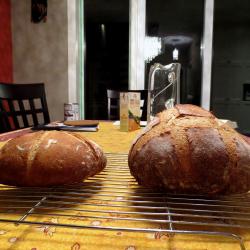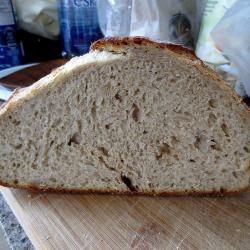
Hi there! I’ve made some improvements in my technique over the last two weeks; my sourdough culture is now stabilized (no more "bubbling out of proportion"), but my main concern now is finding flour that’ll give the best results. After baking 3 loafs that didn’t rise much, with the bubbles escaping from the surface of the dough during proofing, I’ve reviews all the flour types I was using and found a few problems.
- My kamut flour is coarsely ground and doesn’t work very much as an "all-around" bread flour.
- My whole wheat bread flour is too heavy.
- My "all-purpose" organic flour turns out to be, at 9% protein and very low gluten, suitable for cookies and pie crust only.
- Rye flour sold at the local supermarket is stale, with a dusty/irritating smell.
I’ve tried to vary hydration, proofing times and other parameters, with limited success. So yesterday I’ve made a test: baked two loafs, one with a mix of organic flours (mostly kamut) and the other with 2/3 commercial (bleached) bread flour.
LOAF 1
- 1/3 whole wheat, 2/3 kamut
- 60% hydration
- 30% sponge ratio
LOAF 2
- 1/3 white bread flour, 1/3 kamut
- 60% hydration
- 30% sponge ratio
Both recipes used the same amount of water, salt, etc., and technique/timings. They were started 1 hour apart so that I could cook them one after the other. Well you see the comparison in the pictures: LOAF 2 was able to retain its gas, while LOAF 1 fell kinda flat. LOAF 2 has a great grigne (although it’s a bit undercooked) and a nice internal structure.
Looks like I won’t be buying any La Milanaise flour for a while. I’ve found a mill in Soulanges (it’s a 1h30 drive from here!) that looks promising. They offer exquisite flour mixes made of 100% Spring wheat: http://www.moulinsdesoulanges.com/fr/nos-farines-de-specialite
Now I have a few questions for the experts out there...
1) Am I supposed to incorporate the salt during kneading, after autolysis? How is that performed?
2) How can I get bigger holes in my bread? Should I try higher hydration and baguettes, for instance?
3) It seems I get a layer of "compacted" dough right under the crust. Is my bread undercooked, or did its rising "stall" at some point during cooking?
Thanks.


Replies
1) you can mix it in during kneading after autolysis. I am 50/50 on this, I'm not convinced it makes a huge difference and only add salt later (rather than in the initial mixing) sometimes. But all I do is lay the salt on the bench, and gradually roll the dough onto it (during slap and fold kneading), until the salt is all picked up. It seems to even out through the dough fairly quickly (that is, the resultant bread doesn;t have "hot spots" of salt.
2) yes, more water. Also It could be a tad underproved - tearing beyond the pretty-well-expanded slashes, slightly dense structure, fairly vertical loaf (the one that split). You might let it go and find it really flattens out, but at least then you know.
3) I reckon this might be a sign of underproving.
Hello Hugo,
I agree with Davo.
Adding the salt at the start (dry) probably means that it is not completely dissolved anyway during the autolyse so it is doubtful that it would have any deleterious effect on the yeasts etc other than in a very localised area.
What I tend to do is, after I mix the dough, I sprinkle the salt on top of the dough ball and leave it there during the autolyse. During that time it absorbs moisture from the dough and partially dissolves. Five or so minutes before I start the dough development, I fold the salt into the dough using a dough scraper and then let it rest for those few minutes. Then proceed with whatever dough development method you use.
60% hydration is relatively low and 70% is probably a better target for a white wheat flour loaf and higher if you are using wholemeal. Don't be frightened of going higher as you will be surprised at how the dough changes as the development progresses and what seems horribly wet and sticky at the start becomes smooth and elastic later on.
Good luck with your projects.
Farinam
Hi Dan! Thanks for the advices.
I don’t see any matching product when comparing Soulanges and La Milanaise, so I guess they don’t target the same market at all, even though they start with the same wheat. Soulanges has an impressive catalog of high-gluten flour, and La Milanaise sell mostly all-purpose flour (which all seem to be low in proteins, when compared to equivalent products from other mills).
I’ll definitely look for the Saint-Norbert flour.
Also, I could probably arrange something with my local organic food store in Bromont; they will probably accept to buy large 20kg bags and resell it "en vrac" (in bulk), for instance in 1kg bags.
Thanks again!